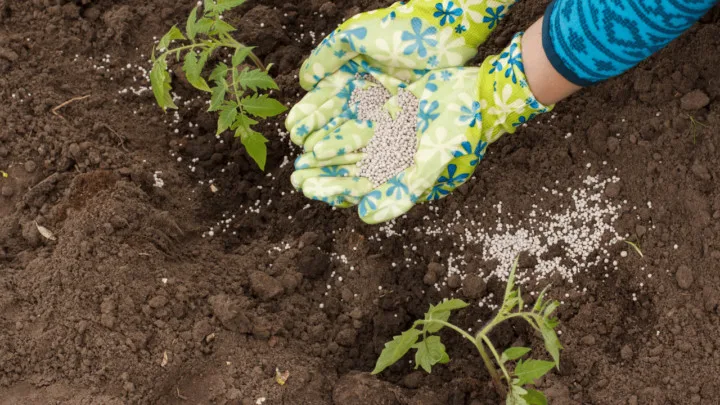In this article, I will reveal the best fertilizers for tomatoes that I have tested.
There are two types of tomatoes, Determinate and Indeterminate. And the fertilization for both types varies.
Determinate tomatoes are also called bush tomatoes. They only grow to a certain height and then become bushy.
Indeterminate tomatoes, on the other hand, are vining types that continue to grow and flower.
The best fertilizer for tomatoes will have macronutrients (nitrogen, phosphorus, and potassium) and micronutrients (magnesium, calcium, zinc, etc.).
With determinate tomatoes, there are two main stages. The growing phase and the fruiting phase. With indeterminate tomatoes, there is only the growing phase and they will need ongoing fertilization.
But it’s important to understand your tomatoes need these nutrients in different ratios at every growth stage.
The first step in choosing the fertilizer for your tomatoes is knowing the nutrient content of your soil and the growth stage of your tomatoes.
Therefore, I highly recommend testing your soil before buying any fertilizer for your tomatoes.
As a vegetable gardener, I am passionate about tomatoes and love sharing my secrets about growing sweet, red tomatoes.
This detailed guide tells you everything about fertilizing tomatoes, and I am sharing the pros and cons of my favorite fertilizers.
Before applying any fertilizer the Cornell University recommends taking a $15 soil test.
We get commissions for purchases made through links in this post.
Best Fertilizers for tomatoes
The best tomato fertilizers have an NPK of 8-32-16 and 6-24-24. High phosphorus (P) and potassium (K) levels are important for fruit sugar and acid content in tomatoes. Potassium, boron, and sulfur are most important for great-tasting tomatoes. An irrigation water pH level between 6.2 and 6.5 is optimal for nutrient intake.
The best fertilizers for tomatoes are:
- Best Overall Tomato Fertilizer – Miracle-Gro Tomato Plant Food
- Best Budget Tomato Fertilizer – Dr. Earth Organic Tomato Fertilizer
- Best Instant Tomato Fertilizer – Osmocote Smart-Release Plant Food for Flowers and Vegetables
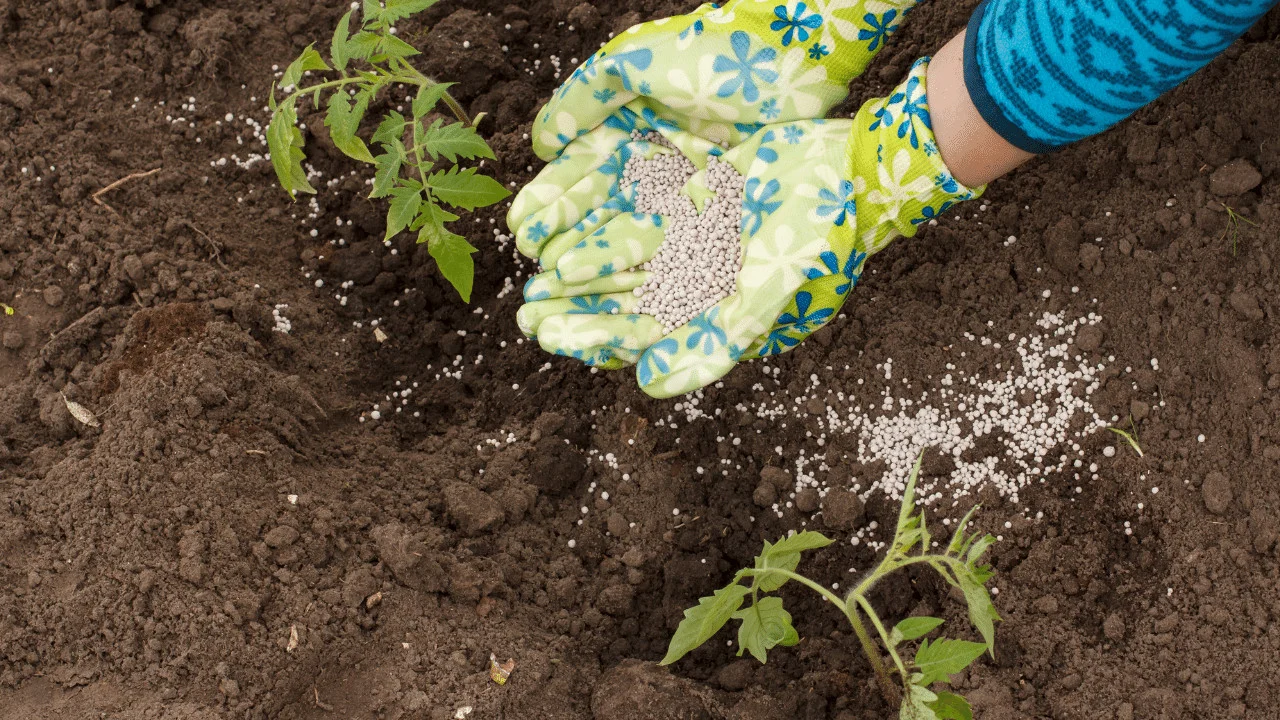
Table of Contents
Best Fertilizer for Tomatoes
Best Overall Tomato Fertilizer – Miracle-Gro Tomato Plant Food
Miracle-Gro products are the top choice of many vegetable gardeners because of the number of options they have for plant food and fertilizers.
They have a wide range of fertilizers for different types of plants. You should definitely try the Tomato Plant Food if you are struggling with your Tomato crop.
This fertilizer will show instant results, and soon you will have healthy and bigger tomatoes. You will notice a significant difference between your fed and unfed tomatoes in terms of growth.
For best results, I would recommend using it every 1 or 2 weeks. This fertilizer is also economical because it can be used for other vegetables in your garden as well.
Simply mix 1 ½ tablespoons of plant food in 1 ½ gallons of water and soak the base soil of your outdoor tomatoes with a watering can. For indoor, small pots, use ½ teaspoon of fertilizer in 1 gallon of water.
For potted plants, a watering can be enough, but for large Tomato crops, it is best to use the Miracle-Gro Garden Feeder.
The N-P-K ratio for this plant food is 18-18-21. Since it is high in potassium, it is best to use it during the initial growth stage for root development. It’s rich in other micronutrients as well.
Avoid storing the mixture for longer than one week. For indoor potted plants, use the foliar application by spraying the mixture on the leaves. But do not do this if your plant is flowering.
If you are starting your vegetables with seeds, avoid soaking the entire seedbed in the mixture; instead, only wet it slightly. Normal application rates are acceptable for established plants.
Miracle-Gro recommends applying this water-soluble fertilizer using their garden feeder or a regular watering can. If you have used the Miracle-Gro soil, you should begin using this fertilizer after 1 month of planting.
For plants already growing in other soils, it is recommended to feed them at the time of transplanting.
Pros
- Can be used for other vegetables
- Safe to use with no harmful effects
- Will not burn your tomatoes if used according to instructions
- It can be used for both seeds and seedlings
- The water-soluble formula makes it easier to apply
Cons
- The leftover mixture cannot be stored for later use
- Some buyers have complained about the product not dissolving well
- It does not contain calcium which is necessary for healthy tomatoes
Buy this product by clicking here.
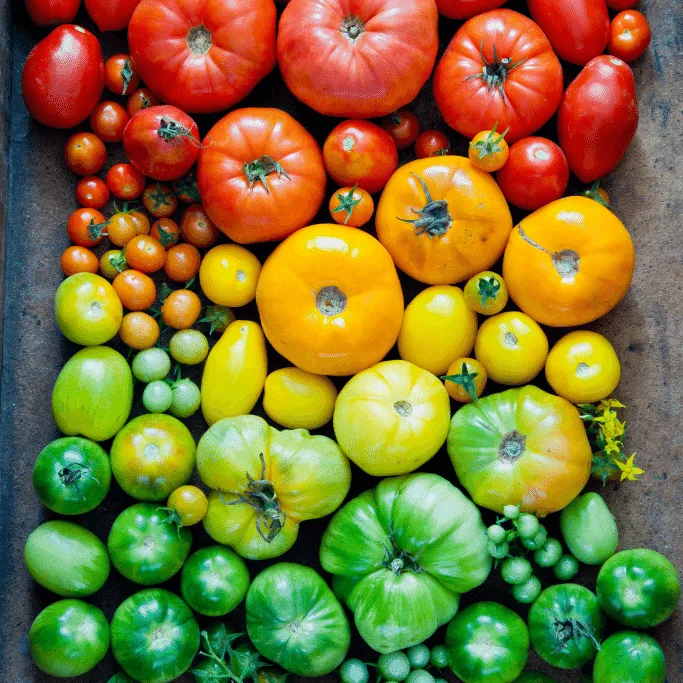
Best Budget Tomato Fertilizer – Dr. Earth Organic Tomato Fertilizer
Dr. Earth fertilizer is designed specifically for tomatoes, vegetables, and herbs.
It has a mild NPK ratio of 4-6-3, but the presence of other micronutrients and elements will make all the difference.
It’s one of the best organic gardening products for edible crops since it has no GMOs, sewage sludge or chicken manure.
This is a dry fertilizer that should be mixed with soil at the base of the plant, and the quantity will depend on the planting conditions.
I would suggest every vegetable gardener to try this organic fertilizer for their indoor and outdoor vegetables. You will be rewarded with healthy, tasty, and nutritious vegetables and tomatoes.
You will not only have healthy tomatoes but also more tomatoes with this organic fertilizer.
This formula will promote vigorous root growth because it has optimum plant nutrients levels. It lasts for several months.
Since the nutrients are released quickly, this fertilizer is the best option to save a dying Tomato crop that needs instant nutrition.
If you use it according to the manufacturer’s instructions, you will not need to apply any additional chemical fertilizer. It has a shelf life of 2 years.
Mycorrhizae is one of the key ingredients in this fertilizer. It ensures the availability of nutrients, improves drought tolerance, and enhances the overall growth/performance of your tomatoes.
It has other organic ingredients like fishmeal, kelp meal, fishbone meal, alfalfa meal, etc. For maximum results and to enrich the soil, it is best to mix the fertilizer evenly in the soil.
And always add water to help the fertilizer dissolve in the soil.
For tomatoes in containers, use ¼ cup of fertilizer for a 5-gallon container. If you want to use this fertilizer before planting your tomatoes, mix 1 ½ cup of this organic fertilizer in each 10 sq ft of growing area.
You should repeat the application every month throughout the growing seasons of tomatoes.
Pros
- 100% natural
- Nutrients are released quickly for faster results
- Certified by OMRI
- Suitable for plants that need a low acid fertilizer
- It can be used as a fertilizer tea
- Easy application
- Contains calcium
Cons
- It has a raw, earthy smell
- It cannot be used for hydroponic gardening
- Cannot be added to the drip irrigation system
- Too strong for young seedlings
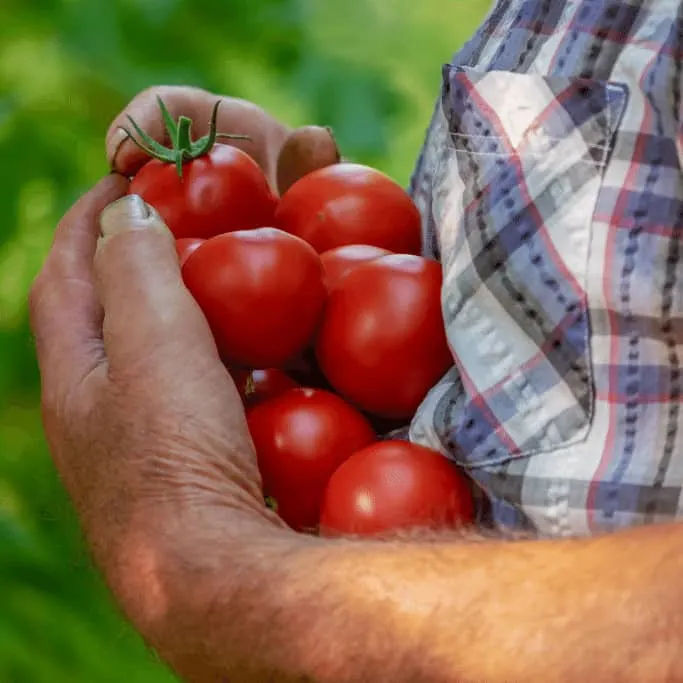
Best Instant Tomato Fertilizer – Osmocote Smart -Release Plant Food for Flowers and Vegetables
This plant food is useful for both top and root growth. It is designed to suit the growing habits of most flowers and vegetables, including tomatoes. It should be used specifically for in-ground vegetables or flowers.
According to most gardeners, this is an excellent product for perennials, and I always keep a spare jar for my vegetables in the growing season. It is proven to enhance the flavor of tomatoes.
This is a balanced fertilizer that has a fertilizer ratio of 14-14-14. It has a good combination of micronutrients as well.
To feed your tomatoes, remove the lid and sprinkle the fertilizer on the soil via the small holes. Make sure you thoroughly mix the fertilizer and water the soil.
The coating of this Osmocote fertilizer reacts at low temperatures; therefore, it is important to fertilize at a cool temperature.
Pros
- A single application lasts for 4 months
- Easy application with holes in the top lid
- Improves the taste of tomatoes
Cons
- Difficult to control the quantity of nutrients
- Suitable for in-ground vegetables
- It has a weird smell
Learn more about this product here.
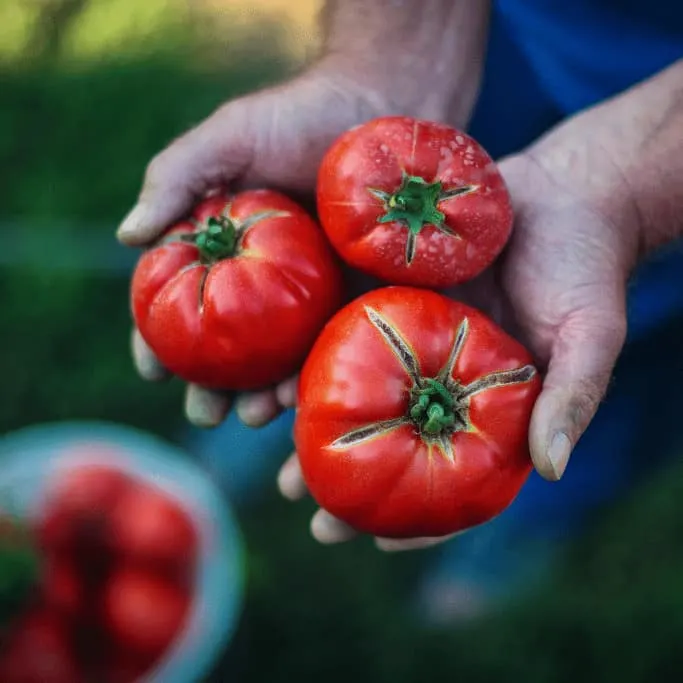
Best Tomato Fertilizer Spikes – Jobe’s Fertilizer Spikes for tomatoes
You can feed your tomatoes with this fertilizer throughout the season without any runoff. Each package contains 18 spikes that are enclosed in a waterproof bag to make sure the product is stored properly.
These time-release fertilizer spikes are great for root development of tomatoes because it ensures continuous feeding below the soil surface. Jobe’s claims that this product is mess-free and does not have any harmful scent.
Use two spikes for each plant. They will last up to 8 weeks, and the NPK ratio is 6-18-6. The application is straightforward; you have to insert the spikes in the ground near the base of the Tomato plant.
I prefer using spikes for most of my plants because the nutrients are not washed away with watering like surface-applied fertilizers.
To use them while planting, place one spike at the front and one at the back of the base of the plant. Make sure they are spaced at a distance of 3 inches.
Pros
- Resealable bag
- Easy to apply
- Can be used for any type of potted vegetables
- Used for both Tomato seedlings and established plants
- One application will last the whole season
Cons
- Not organic
- Some customers have complained about receiving crumbled product or spikes covered in mold.
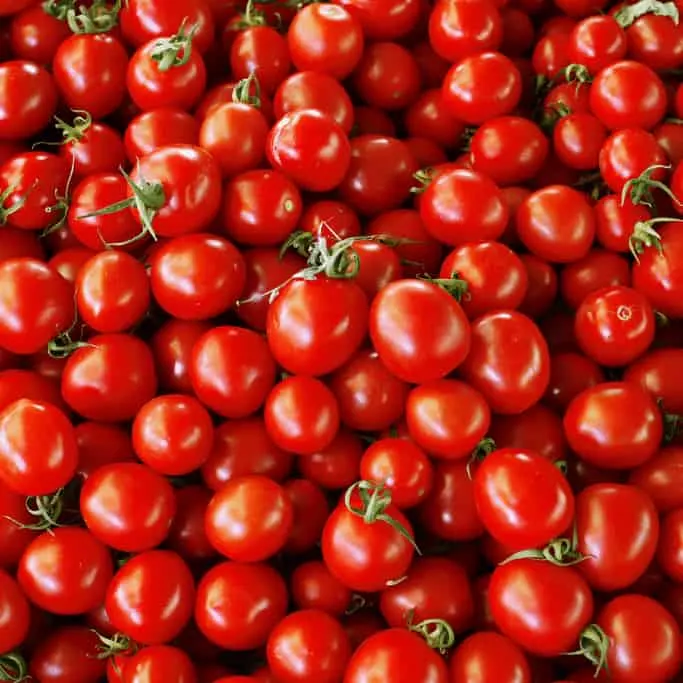
Best Organic Tomato Fertilizer – Espoma Tomato-Tone Fertilizer
This plant food is enhanced with several living soil microbes for organic gardening. It is perfect for Tomato gardening as it ensures continuous feeding and prevents blossom end rot.
Speaking from my experience, before using this, my tomatoes struggled with blossom end rot, but the magic formula with calcium has resolved this issue.
The Tomato tone formula is designed to produce juicy tomatoes every season. Your crop will have more flowers hence more tomatoes with the 3-4-6 NPK ratio. This fertilizer has an approximate shelf life of 5 years.
This grainy, granular product should be mixed directly with soil, followed by thorough watering to help it dissolve and prevent root burns.
Espoma recommends using 1.5 teaspoons of Tomato-tone for a 4″ pot, but I would recommend using half strength to avoid any fertilizer or root burns. Use it every two weeks in the growing season.
For small Tomato seedlings, wait for transplanting and sprinkle a small amount (approximately 3 tablespoons) of product on the soil medium and mix well.
Pros
- Suitable for all types of vegetables
- A complex but organic blend of 15 essential nutrients
- 100 % natural with no toxic ingredients
- Safe for the environment and reduces industrial waste
- Has 8% calcium that plays a major role in preventing blossom end rot
- Long-lasting feeding
- The sealable bag is easy to use
- Can be used as a top dress every now and then
- Increases size of tomatoes
Cons
- Cannot be used in liquid form because it doesn’t dissolve in water
- Not for hydroponics
- Has a stinky smell
- Few customers have complained that it leaves stains on furniture or pot surfaces
Best NPK Tomato Fertilizer – Miracle-Gro Performance Organics Edible Plant Food
This is another great product by Miracle-Gro for Tomato gardening. You can use it for all types of tomatoes, fruits, vegetables, and herbs. With an NPK ratio of 9-4-12, it will instantly supply all the necessary nutrients.
For a bountiful harvest, apply this plant food to your tomatoes every week in the growing season. It can be applied using the Miracle-Gro Feeder or a simple watering can. The soil near the base of the plant should be fully soaked in the fertilizer mixture.
For better results, I like mixing it in a bottle with a lid or cap to make sure the fertilizer is completely dissolved in water.
Unlike some other fertilizers in this guide, this one can be used for both in-ground and potted tomatoes. For outdoor plants, use 2 scoops of fertilizer and for indoor plants, use 1 scoop of fertilizer in 1 gallon of water.
Pros
- OMRI listed and organic
- Good for other edible vegetables and herbs
- Will improve the overall size of the Tomato plants
Cons
- Not for hydroponic tomatoes
- Has a strong smell, which can be difficult to bear if used for indoor tomatoes
- Some customers have complained that the product does not dissolve completely, which can result in fertilizer burns
Fertilizer Spikes
Fertilizer spikes help you supply exact nutrition to plants without any mess because you do not need to measure or dissolve the fertilizer. They are ideal for busy gardeners that need a simple solution for feeding their tomatoes.
In some cases, they are expensive than regular water-soluble or granular fertilizers. But they have other advantages like fewer applications and easy storage.
There are fewer chances of over-fertilizing with spikes since they have a measured quantity of nutrients. You will also not have to worry about the awful fertilizer smell because they are buried underground.
The fertilizer spikes last longer because they will not run off like regular fertilizer. I consider fertilizer spikes slow-release because they work by releasing the nutrients in soil over a certain period of time.
But I would recommend investing in natural fertilizer spikes because they are beneficial for the long-term health of the soil. To apply the spikes, dig a small hole around your plant and add the spikes in damp soil.
Nowadays, several brands have designed organic fertilizer spikes for different types of plants. Choose spikes that have a good amount of phosphorus, nitrogen, and potassium. Most fertilizer spikes last for up to 2 months.
Winner: Jobe’s Fertilizer Spikes for tomatoes
Organic Fertilizer
In-ground tomatoes go through symbiosis. An organic fertilizer will have the necessary soil microbes or fungi to support this process. These fungi or microbes are important because they help in transporting nutrients from the soil.
Organic fertilizers are also eco-friendly and safe for your local water table. Organic fish emulsion fertilizers are rich in micronutrients and other elements such as magnesium and calcium. Calcium can help fight blossom end rot on tomatoes.
These fertilizers will release nutrients slowly; therefore, they last longer. You can buy organic fertilizers in organic or liquid forms.
Although organic fertilizers are expensive than chemical fertilizers, they have long-term benefits for plants, soil, and gardeners.
Winner: Espoma Tomato-Tone Fertilizer
Nutrients for Tomatoes Based on the Growth Stage
Nitrogen
One of the basic but essential nutrients for the growing stage of determinate tomatoes is nitrogen. Your Tomato plant will indicate a lack of nitrogen through the yellowing of bottom leaves.
If you use compost in the beginning and add compost tea after 6 weeks, your plant will have enough nitrogen.
Nitrogen will keep the green parts of your plant lush and healthy because it basically supports leaf growth. If you are using a filler material such as coconut husk in your Tomato soil, your plant will not get enough nitrogen, so make sure you supply extra nitrogen.
Potassium
It accelerates plant growth. It is also important for fruit and flower production. Your plant also needs this nutrient for photosynthesis and to fight certain diseases.
The first supply of potassium should be added right before flowering, and continue using it till the end of the season. The rule of thumb is to choose a fertilizer that has a double rate of potassium compared to nitrogen.
If you would like a simpler solution, you can try the potassium-rich compost fertilizer recipe. Bananas are the special ingredient of this recipe since they are rich in potassium.
Start by collecting few banana peels and chop them into small chunks. Now bury them inside the soil. The peels should be buried deeper than 1 inch if you want plenty of flowers.
Phosphorus
This is the most vital nutrient for tomatoes because it supports the overall growth and development of roots. It also supports the growth of the fruit itself. This nutrient should be supplied in the initial and final stages of growth.
Since phosphorus is the most vital nutrient, let’s learn how to add phosphorus to your Tomato plant. I like using bone meal for phosphorus supply since it is organic.
Before adding bone meal, it is best to check the soil pH. It should not be higher than 7; otherwise, you have to reduce the pH. Bone meal will take around 4 months to fully dissolve in the soil because it is a slow-release fertilizer.
Fertilizer spikes combined with bone meal are a great option for potted tomatoes because they will utilize the soil nutrients quicker than those growing in the garden bed.
From the flowering to the ripe stage, your plant needs a very small amount of nitrogen. Phosphorus is the main supplement for healthy fruit. You can reduce the potassium application to once a week in the fruiting stage.
Micronutrients
They help the fruit in ripening. Magnesium will enhance the overall quality of the fruit. Calcium will ensure the tomatoes are firm and not too soft or mushy.
To fully understand the fertilizer needs of tomatoes, it is important to know the growth stages. During root growth, a phosphorus-based fertilizer would be best.
In my opinion, Tomato seeds do not require any fertilization since they have enough nutrients to sprout the first few leaves. However, Tomato seedlings do require fertilizers.
A simple trick is to plant your tomatoes in large containers or in-ground for sufficient root growth; otherwise, the plant will struggle to absorb the nutrients from the soil.
No matter what type of fertilizer you choose, if your tomatoes do not have enough room for root development, the fertilizer will not reach the plant. The best approach towards deep rooting is to alter your watering techniques.
For Determinate tomatoes, you can clearly distinguish between the growing and fruiting phase. But for Indeterminate tomatoes, you need a regular supply of fertilizer.
Indeterminate tomatoes are vining tomatoes. They continue spreading through the growing season and do not ripe and reach maximum size at once like determinate varieties.
These varieties ripe slowly and ensure a steady supply of tomatoes through the season until frost begins. Therefore, they need frequent application of fertilizer.
Make sure you feed your Tomato crop with a phosphorus-based fertilizer because it promotes fruit growth, whereas nitrogen triggers foliage growth at the expense of fruits/flowers. The middle number in the ratio represents the percentage of phosphorus.
Having only leaves on the Tomato plant is a reaction of excess nitrogen or lack of phosphorus. Always remember that fruiting or flowering plants do not appreciate a large amount of nitrogen fertilizer.
You can also choose a balanced or complete fertilizer with an equal ratio (10-10-10) of all three elements. Tomato fertilizer should also have a reasonable amount of calcium to avoid soft or rotten bottoms.
I prefer slow-release formulas over water-soluble varieties because there are fewer chances of overfeeding your plants with them. Most Tomato plants will not grow roots deeper than 6 or 7 inches; therefore, mix the fertilizer accordingly.
How to add Potassium to Tomato Plants
You can add potassium or potash by adding compost or manure. Some food products are high in potassium and are a great food source for tomatoes. Banana peels, for example, are high in potassium. The concentration here is low overall.
You can also add wood ash or mined rock powder. f you need a quick fix, use potassium sulfate. It is very high in potash as the concentration is above 50%.
You can also mix your own potassium fertilizer water using:
- Water
- Egg shells
- Banana peels
- Wood ash
- Epsom salt
Conclusion About The Best Fertilizers for Tomatoes
A good fertilizer can help you supply all the necessary nutrients for a healthy Tomato harvest.
The best fertilizers for tomatoes are high in phosphorus (P) and potassium (K).
These two nutrients are also important for a great-tasting tomates.
It is important to follow the instructions for fertilizing and never overdo it because over-fertilization is more harmful than under-fertilization.
There is no one fertilizer for tomatoes; I would suggest choosing your fertilizer based on the growth stage of your plant and soil analysis.
If the soil is rich in nitrogen, get a fertilizer with low nitrogen and high phosphorus. Whereas if the soil lacks nitrogen, go for a balanced fertilizer.
I have listed the top 6 best fertilizers for tomatoes in this guide. If you have chosen your favorite Tomato fertilizer, start buying by clicking on the links.

Daniel has been a plant enthusiast for over 20 years. He owns hundreds of houseplants and prepares for the chili growing seasons yearly with great anticipation. His favorite plants are plant species in the Araceae family, such as Monstera, Philodendron, and Anthurium. He also loves gardening and is growing hot peppers, tomatoes, and many more vegetables.
Last update on 2024-11-21 / Affiliate links / Images from Amazon Product Advertising API

